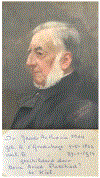Glands of Moll: history, current knowledge and their role in ocular surface homeostasis and disease
- PMID: 40334739
- PMCID: PMC12483061
- DOI: 10.1016/j.preteyeres.2025.101362
Glands of Moll: history, current knowledge and their role in ocular surface homeostasis and disease
Erratum in
-
Corrigendum to "Glands of Moll: history, current knowledge and their role in ocular surface homeostasis and disease" [Progr. Retin. Eye Res. 106 (2025) 101362].Prog Retin Eye Res. 2025 Jul;107:101364. doi: 10.1016/j.preteyeres.2025.101364. Epub 2025 May 21. Prog Retin Eye Res. 2025. PMID: 40399160 Free PMC article. No abstract available.
Abstract
Over the last 20 years, research into the Meibomian glands of the eyelids has increased exponentially and is now widely recognized as a field of research. It is all the more astonishing that knowledge about another type of gland in the eyelids, the Moll glands or ciliary glands, has almost stagnated and there has been little to almost no progress, even though this type of gland as a whole takes up a relatively large volume in the upper and lower eyelids. There is not much information about the namesake Moll or the function of the glands although these are listed in nearly every textbook of anatomy, histology and ophthalmology. For this reason, we set out to compile the existing knowledge about the Moll glands of the eyelids in order to create a basis for follow-up studies and to stimulate research into this type of gland. In our literature research, we went back to the middle of the 19th century and made contact with a descendant of the Moll family and illustrate their relevance for the present. The structure of the secretory part of the Moll glands is very well described, a number of secretory products are known, but the current state of research allows only very rough speculations about their function. The overview provides numerous interesting insights, which, however, raise more questions than they provide answers.
Keywords: Apocrine gland; Ciliary glands; Glandulae ciliares conjunctivales; Jacob Anthonie Moll; Lid margin; Moll glands; Ocular surface; Sweat gland; Tear film.
Copyright © 2025 The Authors. Published by Elsevier Ltd.. All rights reserved.
Conflict of interest statement
Conflicts of interest The authors declare no conflict of interest. The funders had no role in the design of the study; in the collection, analyses, or interpretation of data; in the writing of the manuscript; or the decision to publish the results.
Figures









References
-
- Amorim M, Martins B, Caramelo F, Gonçalves C, Trindade G, Simão J, Barreto P, Marques I, Leal EC, Carvalho E, Reis F, Ribeiro-Rodrigues T, Girão H, Rodrigues-Santos P, Farinha C, Ambrósio AF, Silva R, Fernandes R, 2022. Putative biomarkers in tears for diabetic retinopathy diagnosis. Front. Med 9, 873483. - PMC - PubMed
-
- Asahina M, Poudel A, Hirano S, 2015. Sweating on the palm and sole: physiological and clinical relevance. Clinical autonomic research. Off. J. Clin. Autonom. Res. Soc 25 (3), 153–159. - PubMed
-
- Ask F, 1908. Über die Entwicklung der Lidränder, der Tränenkarunkel und der Nickhaut beim Menschen, nebst Bemerkungen zur Entwicklung der Tränenableitungswege. In: Anatomische Hefte von Merkel und Bonnet, vol. 109.
Publication types
MeSH terms
Grants and funding
LinkOut - more resources
Full Text Sources

